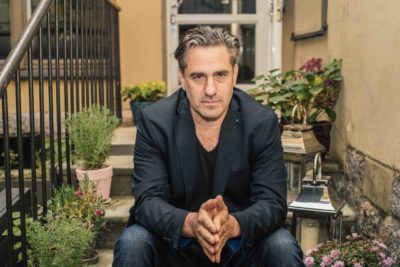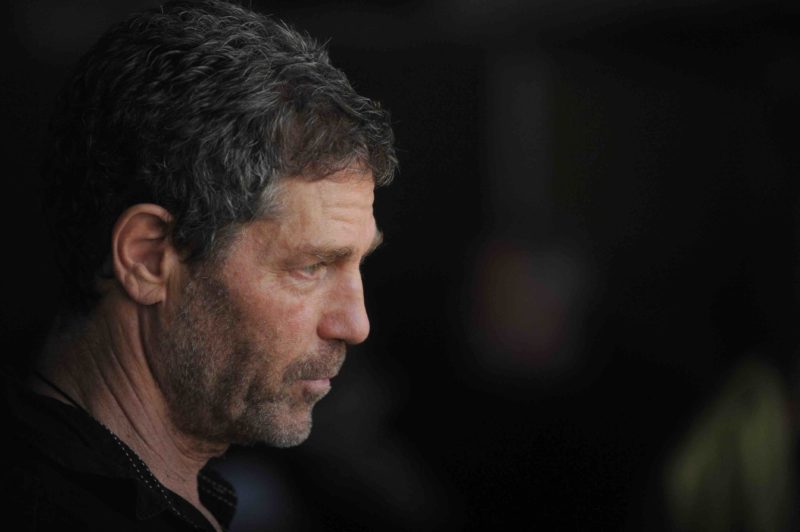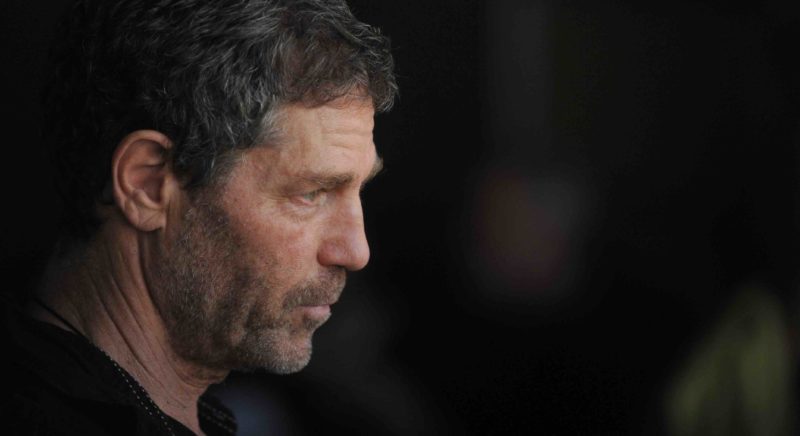INTERVIEW: Director Tomer Heymann digs deep to find Ohad Naharin, aka ‘Mr. Gaga’

Mr. Gaga, which opens Wednesday, Feb. 1 at New York City’s Film Forum, charts the personal and professional passions of famed Israeli choreographer Ohad Naharin, the artistic director of Batsheva Dance Company. The documentary is an all-access pass to understanding the influences on Naharin’s life and how this remarkable artist has changed the world of modern dance.
The film, at times, can feel almost effortless in its presentation of archival footage, dance sequences and interviews. However, the 100-minute feature is very much the result of hard, grueling work on the part of director Tomer Heymann, who worked with his brother, producer Barak Heymann, on the film for years and years.
“It took a long time by the way to convince my brother, [who] was more suspicious about it, and he … tried to understand what’s behind my crazy passion for this project,” Tomer said recently in a phone interview. “We almost closed the company because of Mr. Gaga because it took eight years, and it ate all our budget, and salary and what we saved.”
Tomer admitted that sometimes during the process of making the film his brother would knock him on the head and simply say, “You’re crazy.”
To have his team come around to the idea of making a biography of Naharin, Tomer needed to explain the impact that the choreographer had on his own life. The influence was so strong that he was seemingly incapable of making a “logical” decision about the film. “For me, it’s logical, but always it’s on a different level, more emotional,” he said. “I was 21 when I saw … any kind of modern dance or dance. I’m coming from a different background, from a conservative village from the north of Israel.”
When Tomer moved to Tel Aviv, a large city with a thriving arts scene, the young filmmaker didn’t know too many people. One day, he received a call from a cousin who asked him whether he’d like to see this “new guy in town.”
That was the invitation that changed Tomer’s life. In the early 1990s, Naharin had recently returned from 12 years in New York City to his native Israel. Tomer’s cousin thought he might have heard about the legendary performer, but the director was not acquainted with the world of dance or its luminaries.
“I said, ‘Who is Ohad Naharin?’ I never heard about him. I never heard about Batsheva Dance Company before,” he said. “[His cousin said,] ‘No, but give it a chance. I leave you a free ticket. I just put one free ticket for you, and you are alone in the city. And I heard from your parents you are lonely.’ So nine times she called me. We’re talking about ’91, so it’s before Facebook. You need to call the people, and she called me. Then it was the 10th time she called me, and she said, ‘Tomer, I don’t know what your problem is in life, but this is my last option, my last chance. I’m not running after you anymore. Friday, 2 [p.m.] matinee, if you’re not coming, forget about it’. So I went with no expectation basically.”
Tomer said he was afraid to go to the performance because he was young and shallow when it came to the arts. He envisioned a modern-dance performance to be boring, dry and for older audience members.

After he took his seat and watched Naharin’s mastery on stage, he was a convert, almost instantly. “Man, that was a moment that blew up my mind,” he said. “I flied so high. Funny, I went to the ocean, and I just went to the beach with my clothes because I was almost like drunk with no alcohol in my body. It was so powerful, and I went to see [more] shows. In one month, I saw it 30 times, and I discover every night something else.”
Over the years, Tomer has been struck by so many of the choreographed dances and Naharin’s unique, self-aware body movement coined Gaga. The dances are large-scale affairs that simultaneously convey grandiosity and intimacy. There’s a haunting quality to many of the movements and a transfixing imagery that entices, emotes, scares and surprises. They are visual splendors, and Tomer, a young man finding his own identity in a big city, was hooked on the Batsheva Dance Company’s performances.
“It affected me on a very different level, and I remember telling to myself, wow, I want to meet this man,” he said. “I want to make a movie, but I’m sure someone else will make a movie because the shows, the performances shout: Make movie about me. It’s so cinematic the way Ohad creates these pieces.”
An obsession became a desire, Tomer said, and one day he gathered the courage to knock on Naharin’s door. The choreographer, to be expected, flatly denied the request. With a response like that, Tomer knew it would take a lot of convincing. However, he kept in the back of his mind that image of himself first discovering the dance works and realizing their freeing ability in terms of art, sexuality, identity and character. He remained determined to make the documentary.
“There’s something about the power of art, the meaning of art,” he said. “I’m sure everyone has it. … Maybe with music, maybe with building, maybe with a poem. I don’t know. For me, one guy. His name is Ohad Naharin, [and he] opened the gate of my heart and influenced it so hard. … I was not yet a filmmaker. I was a young man confused, didn’t know what I was going to do with life. … Very powerful moment in life to see that a piece of art, especially dance because it’s so abstract, can take my soul, in this case, to a very high level of emotion. It was a jungle of feelings.”
Eventually Naharin came around to the idea of making the film, but there were challenges along the way. “When I start doing the movie, Ohad was 57, so he’s not a young man anymore,” Tomer said. “[Previously he] didn’t share too much about his private life, and people who are very close to him, like friends and family, were surprised after watching the movie. They came to me and said, ‘Wow, he never shared it.’ When I came to him, he [said], ‘Hey, Tomer, I don’t know, I’m not interested about the personal level. … I like to control the way I share my image with the audience and with the media.'”
Again, it took time, but Naharin began to open up and allow Tomer to explore many avenues, everything from his 1952 birth in Kibbutz Mizra, Israel, to the choreographer’s marriage to dancer Mari Kajiwara, who performed for Alvin Ailey American Dance Theater while the couple lived in New York City. One of the most emotional parts of Mr. Gaga is when Kajiwara died of cancer in 2001. Tomer documents the loss with dignity by allowing those who knew Kajiwara the chance to offer some memories of the dancer. There’s also several scenes depicting Naharin’s recent work and family decisions, including a new marriage and new child.
Tomer said perhaps Mr. Gaga will be a chance for Naharin’s legacy and biography to be a visual reminder to his family and fans of the many loves in the choreographer’s life, both personal and professional.
CHANGES ARE AFOOT
As Tomer learned more about Naharin’s life, he kept changing his interpretive focus when it came to completing Mr. Gaga. This caused delays in the project, but the filmmaker believes they were necessary. “You have to understand, I was filming the shows for the first two, three, four years,” he said. “Thousands of hours I shoot the many, many creations, and then I came to my brother. And I told him, ‘We do it from the beginning because the way I read the shows, or the way I translate it or the interpretive touch I give it, it’s completely different right now because I discovered the biography of this artist.’ So that was another circle.”
One of these shifts occurred after Tomer interviewed Naharin’s mother for 13 hours over the course of two days. During that discussion, the filmmaker heard about Naharin’s family archives. It turns out that the dancer’s family went to Detroit, Michigan, when he was young. He decided to stay behind with his grandmother, but he would send recorded tapes to Detroit to stay connected. Tomer wanted to find this footage.
Here’s how Tomer remembers it: “The mother told me, ‘Tomer, we had it. We had it.’ And I went to Ohad, and I told him, ‘Hey … your mother said you have it.’ He said, ‘Tomer, leave me alone. I don’t have it. [When] I move to Israel with Mari from our apartment from Broadway and 118th in New York, I left everything in this building. I don’t carry memories. I don’t take archives, so go to this building.’ But you know the building does not exist anymore. … What can I do? I need to trust the guy, so I don’t have any access. But something in my stomach told me it’s around somewhere. It needs to be somewhere. I don’t believe they destroyed it or left it.”
Tomer visited Naharin another time and brought up the childhood tapes again. Naharin reportedly told him to go into the basement and look around; anything the filmmaker found could be used for the film. Sure enough, in Naharin’s basement, filled with dust, was the footage Tomer was looking for. “We took [the film] and start to send it to Taiwan to Italy to New York to many places to develop it, and we start to get back amazing footage,” Tomer said.
Many of the memories that Tomer unearthed are included in Mr. Gaga, including the time when Naharin walked away from an amazing opportunity with legendary choreographer Martha Graham. In Tomer’s mind, this pivotal moment in the dancer’s life is crucial when understanding Naharin’s work. “For me, this is all lot about integrity and about reality for yourself as an artist,” he said. “Before he was Ohad Naharin, before he had this company like Batsheva, he said to the big names, ‘No.’ … He would say no to Martha Graham, and he left Julliard very fast.”
Instead, Naharin pursued his own work — work that left him feeling more artistically satisfied. The same could be said of Tomer.
By John Soltes / Publisher / John@HollywoodSoapbox.com
Mr. Gaga will play at New York City’s Film Forum beginning Feb. 1. Batsheva Dance Company will play an engagement at the Brooklyn Academy of Music, Feb. 1-4. Click here for more information on the movie. Click here for more information on the dance performances.

